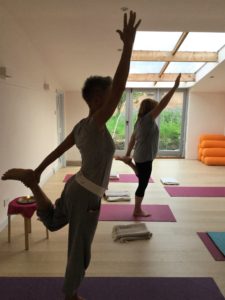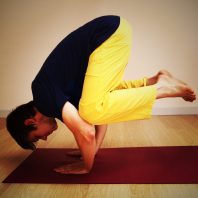A well balanced yoga class includes warm up, inversions, forward bends, backward bends, twists, sideways bends and balances.
Strength Standing and arm balances develop strong muscles in your legs, feet, arms and shoulders, as well as your core. Holding your body against the force of gravity needs muscle contraction. Developed muscles around vulnerable ankles, knees, elbows, shoulders and necks will make your body resilient to knocks, the natural wastage of muscle in older age and injury. Strong contraction also massages the veins deep in the bigger muscles of our limbs, such as the soleus and gastrocnemius (calf muscles). Also, holding our own weight is a great way to maintain bone strength. Bones are living tissue exchanging calcium and other minerals constantly with the blood, other bones and organs. When you stress a bone, not only does it lay down strengthening material in that part but the whole skeleton responds too.
 Muscle and mental control In order to hold the posture practice helps develop muscle intelligence, which manifests as grace. Working against gravity, some individual muscle fibres (cells) must contract while others stretch. Wobbling around the centre of gravity refines control and coordination. This improves overall muscle tone, that is to say the link between the nerves and the muscles. Refining the innervation of the muscles contributes to the overall strength of your nervous system, making you more resilient to change and more able to access mental balance or equanimity. With a more finely tuned nervous system there is greater awareness of thoughts, emotions and even consciousness itself, the ultimate state of yoga.
Muscle and mental control In order to hold the posture practice helps develop muscle intelligence, which manifests as grace. Working against gravity, some individual muscle fibres (cells) must contract while others stretch. Wobbling around the centre of gravity refines control and coordination. This improves overall muscle tone, that is to say the link between the nerves and the muscles. Refining the innervation of the muscles contributes to the overall strength of your nervous system, making you more resilient to change and more able to access mental balance or equanimity. With a more finely tuned nervous system there is greater awareness of thoughts, emotions and even consciousness itself, the ultimate state of yoga.
Mental focus Balances require full attention. You may notice that when holding a balance your breath gets very small, just as if you are focusing on completing a house of cards, for instance, or indeed concentrating in meditation practice. Then, see if you can relax in the holding pose, letting go of extraneous effort, clenching the jaw or scrunching up the mind, for instance. What a great feeling of grace that comes with that ease of finding our centre of gravity.
Emotional resilience and equanimity Nobody can hold novel balances just like that so practice is essential. It is not possible to fake balances. Inevitably you will fall out of the posture and that knocks your ego, especially in class. How do you cope with that? Can you practice self-acceptance and a beginner mentality? These attitudes are part of ongoing yoga and a sign of maturity, and take you a long way in developing true equanimity. To keep going requires both determination and a letting go of expectations, seemingly a paradox: welcome to the world of yoga! So, balances, as yoga in general, promote self-reflection and discernment (viveka in sanskrit) of what is good here. And that is wisdom.
Join classes here, or consider 1-1s. ‘Balance Bonanza’ is one of the workshops run by Fiona sometimes: up to twenty arm and standing balances and their variations for lots of laughs!
